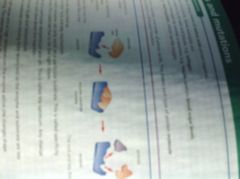![]()
![]()
![]()
Use LEFT and RIGHT arrow keys to navigate between flashcards;
Use UP and DOWN arrow keys to flip the card;
H to show hint;
A reads text to speech;
21 Cards in this Set
- Front
- Back
|
What does the number of mitochondria in a cell depend on? |
On the activity of the cell |
|
|
What occurs in mitochondria |
Respiration |
|
|
Where are mitochondria found |
The cytoplasm |
|
|
Why does the liver and muscle cells have lots of mitochondria |
Liver: carries out many functions so needs lots of energy Muscle cells: need to contract so need lots of energy |
|
|
Where are ribosomes found and how big are they |
Smaller than mitochondria. Found in the cytoplasm.are the site of protein synthesis |
|
|
What does the nucleus conatin |
Genes |
|
|
What is a gene |
It is a section of a chromosome made of DNA. It codes for a particular protein |
|
|
What is the complimentary base pairing |
A-T and G-C |
|
|
What are the four bases and what bases are pairs |
How is amino acids coded for |
|
|
What does mRNA do |
Carries the code needed to produce a protein from the DNA to the ribosomes |
|
|
What do enzymes do |
Proteins- control the activity of the cell |
|
|
What do Watson and Crick do |
Build a model of DNA |
|
|
What are proteins made of |
Long chains of amino acids joined together |
|
|
What different functions do proteins have (4) |
1. Structural proteins, build cells and tissues - collagen 2. Hormones, carry messages to control a reaction- insulin controls blood sugar levels 3. Carrier proteins- haemoglobin carries O2 4. Enzymes |
|
|
What do enzymes do |
Speed up reactions in the body - called biological catalysts |
|
|
E.gs of when enzymes catalyse chemical reactions |
Respiration, photosynthesis, protein synthesis |
|
|
How does an enzyme work |
The lock and key method |
|
|
What is the lock and key method |

Substrate molecule fits into the active site of the enzyme |
|
|
How do enzymes work best |
At their optimum temperature and ph- low temps molecules moving more slow so substrate and enzyme less likely to collide. At too high temps and ph (or too low) active site changes shape(denaturing) so the substrate can't fit and react so quickly |
|
|
How do mutations occur |
Spontaneously/ radiation or chemicals |
|
|
B3a and b |
Ye |

